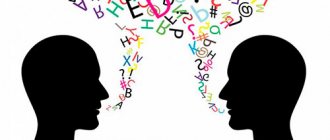Updated July 23, 2021 549 Author: Dmitry Petrov
Hello, dear readers of the KtoNaNovenkogo.ru blog. Each of us has a general idea of what speech is. However, there are significant differences in the understanding of this word by different people.
Even in dictionary interpretations, this phenomenon is referred to either as the activity of the speaker, or as a form of communication, or in general as a person’s psychological ability to express thoughts.
Today we’ll talk about how linguists understand speech, what types and functions they distinguish. Finally, let's figure out what the border is between language and speech.
Concept and properties
The psychology of speech has been studied since the birth of a person. Some people confuse this concept with language, but they are two different terms.
Psychologists distinguish several interpretations of the concept of speech:
- ability, ability of a person to speak;
- an action that a person performs with the help of sounds;
- technology for expressing thoughts through language skills.
Language is a complex, original system of signs with which information can be transmitted orally or in writing.
Properties of speech:
- Understandability is determined by the totality of information and knowledge. To understand another person, you need to understand the terminology and know the specifics of the topic of conversation.
- Content - the number of expressed feelings, thoughts, aspirations in a conversation. Speech can be meaningful or superficial. For the first option, a conversation between two specialists regarding a topic of interest to them is relevant; for the second, an ordinary conversation between two acquaintances on topics that do not arouse strong interest.
- Expressiveness is a property associated with emotional richness. Speech can be energetic, bright, rich or empty, pale, sluggish.
Another property is impact. With the help of beliefs, requests, commands, and other methods, you can motivate a person to action.
What is it like?
A classification of types of speech can exist according to the form in which information is exchanged. That is, speech can be oral (using sounds) or written (using special symbols).
If we focus on the number of participants in communication, then it can be divided into monological, dialogical and polylogical. The style of speech depends on the sphere of communication in which it functions, and can be scientific, journalistic, official business, artistic or colloquial.
The classification of forms of speech according to compositional and structural characteristics, as well as according to content and semantics, classifies any type of speech either as a description, or as a narration, or as a reasoning. Let's take a closer look at each of these divisions.
Functions
When researchers began to study the role of speech in society, they identified two functions of this ability - intellectual and communicative.
Intelligent
Speech acts as a means of education, development, and expression of thoughts. The unit of thinking and speech is the word. Each of them has its own meaning.
Communication
Speech is a tool of communication between people, allowing them to exchange information and encourage action. When creating messages, a person indicates a phenomenon or object in it. To evoke emotions in your interlocutor, you need to form the correct meaning.
The main purpose of verbal meanings is to convey thoughts. This is influenced by the choice of word, the emotional expression that relates to the sounds being spoken.
With the help of tone, facial expressions, intonation, imagery of expressions, selection of words, expression of feelings, you can express a thought. These techniques will help make the message more expressive, rich or faded and empty.
What is dialogue like?
The main part can be from very short to very long. Any dialogue tends to be continued. As an ending, cues of agreement, response, or standard speech etiquette (“goodbye” or “all the best”) are used.
In the sphere of colloquial speech, dialogue is considered everyday and is conducted using colloquial vocabulary. Here, a poor choice of words, repetitions, and deviations from literary norms are allowed. Such dialogue is characterized by emotions and expression, unevenness, variety of topics, and deviation from the main line of discussion.
Dialogue is also found in literary sources. Examples are communication between heroes, a novel in letters, or authentic correspondence of historical figures.
It may or may not be very informative. In the latter case, it consists mainly of speech forms and does not contain useful information. An informative dialogue is characterized by the need for communication in order to obtain new data.
Construction and playback stages
There are several stages of speech construction:
- Formation of thoughts and statements.
- Construction of inner speech. At this stage, the individual thinks about how to convey the idea to the interlocutor.
- Selecting individual or related phrases, assumptions, forming beliefs.
- Selecting individual words, morphemes, composing complete sentences.
The last stage is reproduction of the generated text. For this, different sound signals are used. Speech is supplemented by facial expressions, gestures, changes in tempo, timbre and tone of voice, and emphasis on individual words.
Different types of texts
There are also different types of speech depending on the functions performed. The classification of speech according to this criterion divides it into texts that reflect actual reality and those that contain thoughts and reasoning about it. Depending on the meaning, any of them can be classified as narrative, descriptive or reasoning.
Descriptions depict a phenomenon with a list of characteristics inherent in it. It can be portrait, landscape, interior, everyday, scientific, etc. It is inherently static, and it is built on the main starting point contained in the object itself or its separate part. Thought develops by adding new features to what has been said.
The type called narrative is a story about events and actions that occur over time. Its composition includes a beginning with subsequent development, continuation, climax and ends with a denouement.
Reasoning is understood as confirmation and explanation of a certain thought or statement expressed in words. The composition usually consists of a thesis, its evidence and final conclusions.
History of the study and researchers
It is believed that the first articulate speech appeared about two million years ago. Then the first people developed a speech apparatus.
Psycholinguistics is a branch of psychological science that was formed under the influence of linguistics. Its goal is to study the relationships between consciousness, thinking, and language.
The term “speech” was proposed by the famous American psychologist J.R. Cantor. It became widely used among other researchers after Kantor’s student N. G. Pronko used it in the article “Language and Psycholinguistics.”
One of the main hypotheses that played a huge role in the formation and development of psycholinguistics is the hypothesis of linguistic relativity. After its publication, the scientific world began to actively raise the question of the relationship between thinking and language.
The next scientist who made a huge contribution to the study of speech was N. Chomsky. In his works, he described the work of language when constructing phrases and sentences.
The domestic psychologist who made a great contribution to the development of this direction of psychological science is L. S. Vygotsky. He formed a sequence of actions before reproducing the words. It consists of several elements:
- motivation;
- formation of thoughts;
- internal construction of the sentence;
- choice of words;
- implementation.
Let's talk about monologues
What is a monologue? Examples of it are no less common. This term denotes the statement of someone in an expanded form, intended for oneself or others and having a certain organization in the sense of composition and completeness. In a work of art, a monologue can become an integral component or an independent unit - for example, in the form of a one-man show.
In public life, speeches by speakers, lecturers, and speeches by radio and television announcers are practiced in the form of a monologue. Monologues are most characteristic of book speech in oral form (speeches in courts, lectures, reports), but it may not have a specific listener as its addressee and may not imply a response.
According to the purpose of the statement, this form of speech is either informational, persuasive, or stimulating. Informational is a monologue conveying knowledge. Examples are the same lectures, reports, reports or speeches. Persuasive speech is focused on the emotions of those who will listen to it. These are congratulations, parting words, etc.
Incentive speech, as the name suggests, is designed to motivate listeners to take certain actions. Examples include calls, protests and speeches by politicians.
Theories
During the entire period of formation and development of the ability, various theories have been put forward regarding this communicative tool. Modern scientists supported constructivist, relativist, preformist theory.
Preformist
Preformist theory was proposed by N. Chomsky in 1968. The scientist argued that different languages of the world have a similar structure. The opinion of preformationists agree that the human brain contains an initial structure that is determined by heredity.
Therefore, a person can change the meaning of phrases, understand their meaning, and construct meaningful statements, the number of which is unlimited.
At the same time, preformists do not deny that the development potential of a child depends on his environment, interactions with loved ones, the use of upbringing and teaching methods (parents, kindergarten, school, various educational institutions).
Constructivist
Constructivist theory is popular among researchers. According to it, the formation and development of the ability depends on the child’s inherent ability to process and perceive information from birth. A confirming example of this theory is spontaneous word creation in children at an early age. It is believed that children's first words are related to facts that they already understand. In addition, they can speak out about what interests them. Motivation has a huge impact on the formation of ability.
Relativistic
Another popular theory is relativistic. According to it, different languages can be considered from the perspective of the culture of the people, the nation. Each culture has different ways of constructing language. Many scientists are confident that the general picture of worldview depends on the language a person speaks, but when studying the linguistic characteristics of different nationalities of the world, this statement was refuted.
Polylogue - what kind of animal?
The classification of speech styles has recently (end of the last century) been supplemented with the concept of polylogue. Even among linguists it has not yet come into widespread use. This is a conversation between several people at once. Situationally, it is closer to dialogue, as it unites listeners and speakers. There is polylogue in the forms of discussions, conversations, games, meetings. There is an exchange of information contributed by everyone, and everyone is aware of what is being discussed.
The rules by which a polylogue is constructed are as follows: participants are instructed to speak convincingly and quite briefly; everyone who composes it is obliged to follow the plot of the discussion and be attentive; it is customary to ask questions and clarify unclear points, as well as make the necessary objections. The polylogue must be conducted in a correct and friendly manner.
Kinds
The ability is oral and written. These tools allow you to express the thought that an individual has formed.
Oral
A communication tool, when activated, a person pronounces words and perceives verbal messages from others by ear.
There are two types:
- Monologue is a type of speech that does not require interlocutors to express it. One person says something, others listen. More often, thoughts conveyed through a monologue are more detailed.
- Dialogical - used when talking between different people. Characterized by situationality and incomplete deployment.
A huge role in dialogue is given to facial expressions, gestures, intonation, emotional background, and other non-verbal means of communication.
Written
It is realized using various forms that are accessible to visual perception. It is fixed to some material (usually a sheet of paper).
This speech cannot be called living or belonging to a person. It is impersonal because there is a gap between its formation and presentation to the reader.
About writing
Written speech is not intended for a specific interlocutor and depends entirely on the writer. As already noted, it arose at a historically later stage of human development and exists in the form of an artificially created sign system designed to record spoken sounds. That is, signs to designate emitted sounds serve as its material carriers.
Unlike oral speech, written speech not only serves for direct communication, but also allows one to assimilate and perceive knowledge accumulated throughout the development of all human society. Such speech is a means of communication in cases where direct dialogue is impossible, when the interlocutors are separated by time or space.
Study methods
To study abilities, psychologists and linguists use different methods:
- Observation. The total time spent on conversations with others and monologues, gestures, facial expressions, changes in tone, tempo, and expressiveness is taken into account. When observing, natural thinking is maintained, which is a huge advantage.
- Conversation. An effective method for studying ability. With its help, you can find out the interlocutor’s attitude to the assigned task, evaluate mental capabilities, and learn language skills. During the conversation, direct or indirect questions may be asked.
- Experiment. Researchers create conditions for the subject and change them to obtain information. Additionally, data on brain function can be read using specialized equipment.
- Questioning. Used to study thinking. Questionnaires are prepared in advance, questions are selected on one or more topics of interest. A detailed result is given by open-ended questionnaires that force the subject to activate his thinking.
- Testing. Allows you to measure the level of intellectual development and find out the features of thinking.
Researchers analyze the data obtained and draw conclusions.
Colloquial
It is used when we share our feelings with someone, express a thought in a normal conversation. It has its own characteristics - for example, incomplete sentences (“I’ll go” instead of “Yes, I’ll go to the cinema today”). Often, getting carried away by a conversation, interlocutors may lose the thread of the conversation or move away from the topic - this can also be considered one of the signs of a conversational style, as well as the use of colloquial expressions (“stunned”, “mess”, “go to hell”).
- Vaska, did you smash your mother’s favorite vase? She was so beautiful, with flowers! Well, now expect a scandal!
Physiological basis
Why is a person able to speak clearly and conceptually, but animals are not?
In humans, in comparison with animals, in the process of evolution, more mobile lips and tongue (as an organ) became the prerequisites for the formation of speech.
The oral cavity increased, which made it possible to pronounce many sounds with a unique tonality, the difference in which is perceptible by ear.
Humans also have a well-developed auditory zone, which allows them to understand spoken words.
The ear zone is larger in itself (in comparison with the animals closest to humans - monkeys), plus speech centers are concentrated in it. They are responsible for clear and acute perception of sounds.
Test on the topic
- /10
Question 1 of 10How many types of speech are there in the Russian language?
Start test
Hall of Fame
To get here, take the test.
- Lyubov Khomenko
9/10
- Knock Knock
9/10
- Kirill Dudarev
9/10
- Sergey Efremov
9/10
Scientific
This style is typical for encyclopedic articles, textbooks and any other texts containing scientific information. Its features include the use of scientific terminology, logic, structured statements, impersonality (feelings and emotions are not important, facts are important, so the author’s personality does not appear in the text).
A vase is an elegantly shaped vessel with painted or molded decorations, made of clay, porcelain, stone, glass, metal and other materials.








